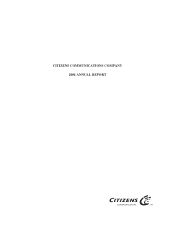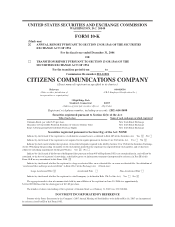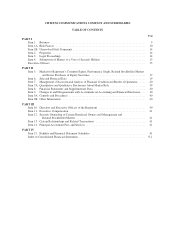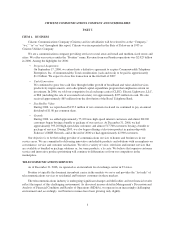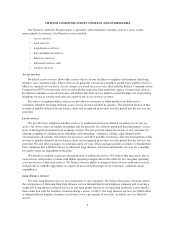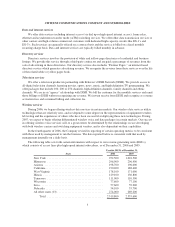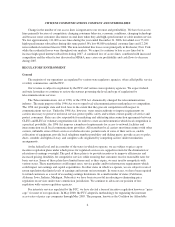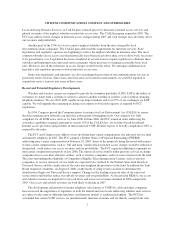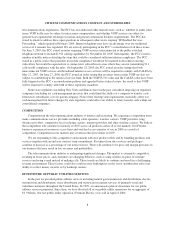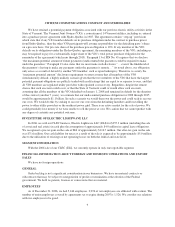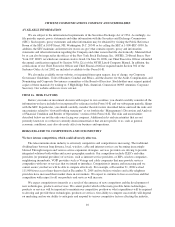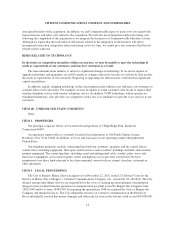Frontier Communications 2006 Annual Report Download - page 7
Download and view the complete annual report
Please find page 7 of the 2006 Frontier Communications annual report below. You can navigate through the pages in the report by either clicking on the pages listed below, or by using the keyword search tool below to find specific information within the annual report.CITIZENS COMMUNICATIONS COMPANY AND SUBSIDIARIES
Change in the number of our access lines is important to our revenue and profitability. We have lost access
lines primarily because of competition, changing consumer behavior, economic conditions, changing technology
and because some customers disconnect second lines when they add high-speed internet or cable modem service.
We lost approximately 111,000 access lines during the year ended December 31, 2006, but added over 75,100
high-speed internet subscribers during this same period. We lost 98,800 residential customer lines and 12,200
non-residential customer lines in 2006. The non-residential line losses were principally in Rochester, New York,
while the residential losses were throughout our markets. We expect to continue to lose access lines but to
increase high-speed internet subscribers during 2007. A continued loss of access lines, combined with increased
competition and the other factors discussed in MD&A, may cause our profitability and cash flows to decrease
during 2007.
REGULATORY ENVIRONMENT
General
The majority of our operations are regulated by various state regulatory agencies, often called public service
or utility commissions, and the FCC.
Our revenue is subject to regulation by the FCC and various state regulatory agencies. We expect federal
and state lawmakers to continue to review the statutes governing the level and type of regulation for
telecommunications services.
The Telecommunications Act of 1996, or the 1996 Act, dramatically changed the telecommunications
industry. The main purpose of the 1996 Act was to open local telecommunications marketplaces to competition.
The 1996 Act preempts state and local laws to the extent that they prevent competition with respect to
communications services. Under the 1996 Act, however, states retain authority to impose requirements on
carriers necessary to preserve universal service, protect public safety and welfare, ensure quality of service and
protect consumers. States are also responsible for mediating and arbitrating interconnection agreements between
CLECs and ILECs if voluntary negotiations fail. In order to create an environment in which local competition is
a practical possibility, the 1996 Act imposes a number of requirements for access to network facilities and
interconnection on all local communications providers. All incumbent local carriers must interconnect with other
carriers, unbundle some of their services at wholesale rates, permit resale of some of their services, enable
collocation of equipment, provide local telephone number portability and dialing parity, provide access to poles,
ducts, conduits and rights-of-way, and complete calls originated by competing carriers under termination
arrangements.
At the federal level and in a number of the states in which we operate, we are subject to price cap or
incentive regulation plans under which prices for regulated services are capped in return for the elimination or
relaxation of earnings oversight. The goal of these plans is to provide incentives to improve efficiencies and
increased pricing flexibility for competitive services while ensuring that customers receive reasonable rates for
basic services. Some of these plans have limited terms and, as they expire, we may need to renegotiate with
various states. These negotiations could impact rates, service quality and/or infrastructure requirements which
could impact our earnings and capital expenditures. In other states in which we operate, we are subject to rate of
return regulation that limits levels of earnings and returns on investments. In some states, we have been required
to refund customers as a result of exceeding earnings limitations. In a small number of states (California,
Alabama, Iowa, Indiana, Michigan, Nebraska), we have been successful in reducing or eliminating price
regulation on services under state commission jurisdiction. We continue to advocate our position of less
regulation with various regulatory agencies.
For interstate services regulated by the FCC, we have elected a form of incentive regulation known as “price
caps” for most of our operations. In May 2000, the FCC adopted a methodology for regulating the interstate
access rates of price cap companies through May 2005. The program, known as the Coalition for Affordable
6

